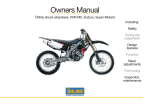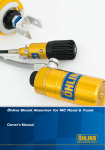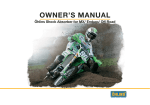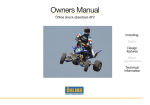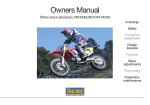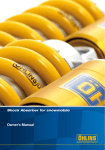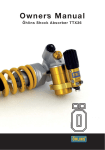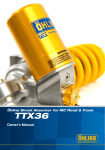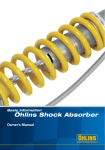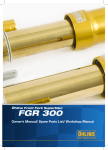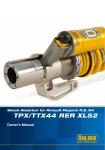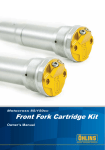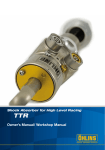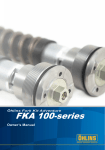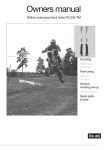Download "service manual"
Transcript
Shock Absorber for ATV Owner’s Manual Introduction Öhlins Racing AB - The Story It was the 1970’s, a young man named Kenth Öhlin spent most of his spare time pursuing his favourite sport: motocross. A careful observer, Kenth’s attention was continually drawn to one specific detail motocross bikes had more engine power than their suspension could handle. It was not long before Kenth realised that better performance could be achieved by improved wheel suspension. Öhlins Racing was established in 1976, and just two years later the company won its first World Championship title. Despite being in the business for 30 years, the search for perfection and new functions is still the main focus of the company. Congratulations! You are now the owner of an Öhlins Shock Absorber. More than one hundred World Championships and other major world titles are definitive proof that Öhlins shock absorbers offer outstanding performance and reliability. Every product has gone through rigorous testing and engineers have spent thousands of hours, doing their very best to use every possible experience from our 30 years within the racing sport. The product that you now have in your possession is pure racing breed that is built to withstand. By installing this shock absorber on your vehicle you have made a clear statement… you are a serious rider with a focus on getting the maximal handling ability and outstanding feedback from your vehicle. Along comes the fact that your shock absorber will be a long lasting friend, delivering the very best of comfort and performance every time you go for a ride. Go explore! Safety Precautions Note! Safety Symbols The shock absorber is a very important part of the vehicle and will therefore affect the stability. Read and make sure that you understand the information in this manual and the mounting instructions before you use this product. If you have any questions regarding installation or maintenance please contact your nearest Öhlins dealer. In this manual, mounting instructions and other technical documents, important information concerning safety is distinguished by the following symbols: The Safety Alert Symbol means: Warning! Your safety is involved. Öhlins Racing AB can not be held responsible for any damage to the shock absorber, vehicle, other property or injury to persons, if the instructions for installing and maintenance are not followed exactly. Warning! The Warning Symbol means: Failure to follow warning instructions can result in severe or fatal injury to anyone working with, inspecting or using the shock absorber, or to bystanders. Warning! This product was developed and designed exclusively for a specific vehicle model and should only be installed on the intended vehicle model in its original condition as delivered from the vehicle manufacturer. Caution! The Caution Symbol means: Special precautions must be taken to avoid damage to the shock absorber. Note! This product contains pressurized nitrogen gas (N2). Do not open, service or modify this product without proper education (authorized Öhlins dealer/distributor) and proper tools. The Note Symbol indicates information that is important regarding procedures. After installing this product, take a test ride at low speed to make sure that your vehicle has maintained its stability. Note! When working on this product, always consult your Vehicle Service Manual. This Manual should be considered as a part of the product and should therefore accompany the product throughout its life cycle. © Öhlins Racing AB. All rights reserved. Any reprinting or unauthorized use without the written permission of Öhlins Racing AB is prohibited. Printed in Sweden. Contents Introduction Safety Precautions Contents Design Functioning Design - TTX Functioning - TTX General Set-up Check Sag and Ride Height Spring Preload CSC - Chassis Stability Control Compression and Rebound Setting up your Vehicle General Guidelines Inspection and Maintenance Page 1 2 3 4 5 6 7 9 10 11 12 13 14 15 17 Design Most of Öhlins suspensions are a high pressure monotube type. The fluid is put under gas pressure and the gas and the fluid are kept apart by a separating piston. The piston is usually fitted in an external reservoir, connected by a hose (Fig. 1.1) or fixed directly on top of the shock absorber, Piggyback (Fig 1.2). There are also models where the separating piston is fitted inside the main shock absorber, Internal gas reservoir (Fig 1.3). The most advanced shock absorber model has two pistons to obtain a progressive damping system (PDS) (Fig 1.4). This ensures position sensitive damping in relation to the degree of compression. One piston is active throughout the entire stroke length, while the second piston is activated when the shock absorber is subject to powerful compression. The fluid is pressurized with nitrogen. The pressurisation prevents cavitation of the fluid and the shock absorbing action is therefore more even. The external reservoir also contributes to better cooling of the fluid, giving longer service life for the fluid as well as the components. Öhlins shock absorbers have an integrated temperature compensation. As the temperature increases and the fluid flows more easily the flow is controlled accordingly. The shock absorbing effect is therefore independent of the temperature. The advanced shock absorber models permit individual adjustment of compression and rebound damping, making them adaptable to most vehicles, drivers and ranges of use. All of the shock absorbers with springs have adjustable preload of the spring action. 1 3 2 4 N2 Fluid Fluid Separating Piston N2 PDS Piston Functioning Compression damping When movement of the vehicle causes compression of the shock absorber, the fluid flows through the needle valve (combined compression and rebound valve) in the piston rod. If the velocity of the compression movement is high, i.e., in the case of rapid compression, this will not be sufficient and consequently the shims underneath the piston will open to allow for a greater rate of flow. The fluid that is displaced by the volume of the piston rod is forced into the external reservoir via a separate compression valve. The separating piston is displaced, thus increasing the gas pressure. Fluid is forced through needle valves at a low rate of flow (Fig 5) and through a number of orifices in the piston (Fig 6) at a high rate of flow. The flow through these orifices is regulated by shims (thin steel washers) that at high pressure are deflected to open for the fluid. On most models the needle valve can be adjusted from the outside. By altering the size of the shim-stack (Fig 7) (i.e. number, thickness, diameter) the characteristics of the damping action can be changed. This should only be done by an authorized Öhlins service workshop. 5 Rebound damping When the spring forces the shock absorber to extend again, the fluid flows back through the needle valve. The fluid flowing into the chamber is forced by the pressure of the gas back into the shock absorber via a separate one way valve. If the piston velocity is high, the shims on top of the piston will also open to allow the fluid to flow through. 6 7 Stop washer Shim stack Rebound flow Compression flow Piston Design - TTX The Öhlins TTX shock absorber is the most unique and powerful racing shock absorber available today. The TTX shock absorber design is the culmination of two decades of Öhlins successful participation in World Championship events. The TTX shock absorber is designed to handle the demanding damping characteristics needed for all types of tracks, from hard packed soil to soft sand tracks. The Öhlins TTX features a patented concept with a unique twin tube design that allows for the gas pressure to always back-up the lowpressure side of the piston to keep pressure at a controlled level. Also the twin tube design gives the possibility to have totally separated adjusters for compression and rebound damping. The CSC adjuster is another benefit, it is an adjuster that changes the damping force, balanced and predictable on both compression and rebound at the same time to control the chassis stability. The temperature stability is maintained by using a flow restriction design in the bleed valves that create a turbulent flow at very low piston velocities. Also, materials with different thermal expansion rates are used to compensate for the viscosity change of the fluid caused by changes in temperature. The Öhlins shim system offers infinite combinations of shim stacks with a wide spectrum of different character with one and the same piston. The whole system is pressurized by nitrogen gas behind a floating piston to ensure separation of the gas and fluid. The Öhlins TTX shock absorber is a racer friendly shock absorber, easy to set up, dial in and rebuild. Support is always available from the Öhlins distributors worldwide. Functioning - TTX Rebound Damping When the spring forces the shock absorber to extend again (Fig. 4), the fluid below piston is pressurized and has to move. In a similar pattern the flow takes four different routes: Now it is the volume above piston that increases and is filled up with flow from piston rebound shim valve and CSC adjuster bleed valve. The gas pressure from the reservoir also pushes fluid into this volume. The fluid that was displaced into the reservoir during compression movement is now pushed back into the main body by the pressure of the gas. 1. CSC adjuster bleed valve. 2. Piston rebound shim valve. 3. Rebound adjuster bleed valve. 4. Rebound adjuster shim valve. Fig 3 Fig 4 Functioning - TTX When the shock absorber moves, the fluid inside is forced to flow through two types of orifices. Bleed valves (Fig. 1), small orifices that create a flow restriction simply by being small and shim valves (Fig. 2) where fluid pressure has to deflect thin steel washers (shims) to open up an orifice and allow fluid flow through it. To control damping force the bleed valves can be changed in size by the external adjusters, CSC, compression and rebound. By altering the size of the shim stack (number, thickness, diameter and shape) on the shim valve the characteristics of the damping action can be changed. Note! Altering the size of the shim stack should only be performed by an authorized Öhlins service workshop. Shim valve flow Bleed valve flow Check valve flow Compression Damping When movement of the motorcycle causes compression of the shock absorber, (Fig. 3) the fluid above the piston is pressurized and has to move. It has four different escape routes: 1. CSC adjuster bleed valve. 2. Piston compression shim valve. 3. Compression adjuster bleed valve. 4. Compression adjuster shim valve. Fluid will at every compression movement use all these routes but at slow movement speeds the percentage going through the bleeds is higher and at fast movement the shim valves take care of most of the flow. The volume below the piston increases and has to be filled up with fluid, if the flow coming in through the piston compression shim valve and CSC adjuster bleed valve is not enough the gas pressure from the reservoir pushes fluid in via a check valve in the rebound adjuster valve. During compression movement piston rod volume is entering the main body and the corresponding volume of damper fluid has to flow into the reservoir, the separating piston Fig 1 moves resulting in an increased gas pressure. Fig 2 General Set-up The ATV has a rear axle but no differential, which means that turning is mainly managed by sliding (Fig 8). Therefore, an extremely good traction is undesiderable. The rear end must easily break loose to slide, and the turning radius for the front wheels must not be too sharp, since this may cause the ATV to tip. Fig 8 Steering by sliding the rear end. Fig Shock Absorber Position These factors make it even more important for the suspension to be adjustable. Any change of the components mentioned above, will require different set‑up. Another important issue is that the performance of the vehicle is also affected by the technique and skill of the driver and of course the driving situation. Therefore, it is extremely hard to recommend a perfect set‑up. The best recommendation is to try and by trial and error decide which set‑up is the most favourable for you. In this manual we give basic advise on how to set up your vehicle and the shock absorber. Read the manual carefully and if you have any questions about the shock absorber or setting up, please contact your nearest Öhlins Authorized Dealer for advise. Normal vehicle steering by turning the front wheels in the intended direction. Warning! The ATV is extremely depending on what tires are being used. The suspension must be tuned in every time you change tires. Warning! Every change in suspension geometry, for example change A-arms, must be followed by checking the set‑up for the shock absorber. The tires are another important factor to the vehicle’s traction. Pattern, sidewall flexibility and air pressure affects these characteristics. Changing the dimension of the A-arms, swing arm and linkage will therefore affect the vehicle’s stability. Check Sag and Ride Height Warning! Recommended Measures Before riding, always ensure that the basic settings made by Öhlins are intact. Take notes, adjust in small steps and make only one adjustment at a time. Free Sag General recommendation (If no other measure given in the Mounting Instructions) 30±5 mm Step 1 Ride Height See the Mounting Instructions. Measure Ride Height and Free Sag . Put the ATV on a stand so that the wheels barely touch the ground. . Measure the separate distances from the top centre of the axle to a point right above them on the frame. (F1, R1) . Put the ATV on the ground and make the same measurements (F2, R2). 4. The difference between the first and the second measure is the free sag. Free Sag = F1-F2 (Front) R1-R2 (Rear) 5. Sit on the ATV in normal riding position, properly outfitted in your riding gear. Repeat the measuring procedure (F3, R3). 6. The difference between the first and the third measure is the ride height. Ride Height = F1-F3 (Front) R1-R3 (Rear) Step 2 . Free Sag: If your measures differ significantly from the recommendations in the Mounting Instructions or the recommendation above, adjust the spring preload. (See chapter Spring Preload in this manual). . Ride Height: If the ride height still differs from the recommendations, you may need to change to softer/harder spring. Contact your Öhlins dealer for advice. 10 Spring Preload Spring Preload When adjusting the spring preload you move the spring seat. This will decrease or increase the initial spring force, which will lower or raise the vehicle rear ride height. The spring preload is fundamental for the suspension performance. If the preload is incorrectly set, any other adjustments will not help to get the intended performance from the suspension. Single Spring Shock Absorber A B How to Set Spring Preload A B Single Spring Shock Absorber Use a C-spanner. Unlock the lock nut (1a) and move the spring platform (1b) to the desired position. After adjusting, lock the lock nut. Free spring length Installed spring length Shock absorber fully extended A - B = Spring Preload Spring Preload is the difference between the measures A and B. Dual Spring Shock Absorber 1 2 1a 1b A Dual Spring Shock Absorber Short spring stroke adjuster - Cross Over The total spring characteristics can be adjusted by moving the spring platforms on the floating sleeve (3). The spring platform position decides when the stroke for the short spring is blocked. At this point, the total spring stiffness will increase on compression stroke. B 3 Circlip Cross over Fig 2: A - B = Spring Preload Adjust the total preload by moving the upper spring seat circlip to another groove. See Set-up Data in the Mounting Instructions for recommended Preload. Sleeve Spring platform 11 CSC - Chassis Stability Control CSC Adjuster Use an allen key and turn the screw to set the CSC. Turn clockwise to close the valve and thereby to increase the damping. Turn counter clockwise to open the valve, and thereby decrease the damping. See recommended Set-up data in the Mounting Instructions for the shock absorber. The new unique CSC valve controls the bleed flow over the main piston. The flow is controlled in compression as well as rebound stroke and, due to the TTX function, has particularly high effect on the low speed movements (chassis movements). Since the flow over the main piston is parallel and not serial to the compression and rebound adjusters, there is a unique possibility to separate the over all damping from compression and rebound damping. The individually controlled one way valves in the compression and rebound adjusters separate the function from the adjusters and also separate slow speed-long stroke movements over the main piston. The CSC valve also controls and compensates for heat effects. The adjuster makes sure that temperature changes are under control and will keep your setup regardless of weather conditions. If you are unsure how far you can tune your TTX shock absorber, start with testing the CSC valve and you will immediately feel the differences in over all damping, stability and chassis movements. Make sure that spring, spring preload and CSC valve are correctly adjusted and your fine tuning will be easy and enjoyable. Note! Since the CSC valve is designed to compensate for temperature changes, the number of clicks will differ slightly between a cold and a warm shock absorber. The recommended setting is at room temperature. Caution! Do not use force, delicate sealing surfaces can be damaged. 12 Compression and Rebound Compression and Rebound Damping Compression damping controls the energy absorption when the shock absorber is compressed, thus controls how easy the shock absorber compresses when the wheel is being loaded or hits a bump. Rebound damping controls the energy absorption when the shock absorber is being extended and controls how fast the shock absorber returns to its normal position after being compressed. Adjust compression and rebound damping by turning the adjusters. The adjusters have a normal right hand thread. 1 2 How to Adjust Compression Damping . Adjust by turning the adjustment knob on the cylinder head. Turn clockwise to increase damping, turn counter clockwise to decrease. . High and Low Speed Compression Damping: High speed: Turn the hexagon screw. Low speed: Turn the slotted centre screw. Turn clockwise to increase damping, turn counter clockwise to decrease. . TTX Shock Absorber; Turn the gold coloured adjuster on top of the reservoir. Use an allen key. Turn clockwise to increase damping, turn counter clockwise to decrease. 3 5 4 How to Adjust Rebound Damping 4. Turn the adjuster knob just above the end eye. Turn clockwise to increase damping, turn counter clockwise to decrease. 5. TTX Shock Absorber; Turn the black coloured adjuster on top of the reservoir. Use an allen key. Turn clockwise to increase damping, turn counter clockwise to decrease. Instructions for the shock absorber. Contact an Öhlins distributor if you have any questions regarding correct set-up. To reset Turn the adjuster clockwise to fully closed position (position zero [0]). Then, turn counter clockwise to open, and count the clicks until you reach the recommended number of clicks. See recommended Set-up data in the Mounting Caution! Do not use force, delicate sealing surfaces can be damaged. 13 Setting up your Vehicle Compression Damping If the vehicle feels soft, has low riding position and a tendency to bottom easily in long dips the compression damping should be increased. Turn four (4) clicks (steps) clockwise and take a test run. Adjust two (2) clicks (steps) back if necessary. If the vehicle feels harsh and has hard resilience, for example over changes in the riding surface, then the compression damping should be reduced. Turn counter clockwise four (4) clicks (steps). Test run and adjust if necessary two (2) clicks (steps). Warning! Before riding, always ensure that the basic settings made by Öhlins are intact. Take notes, adjust in small steps and make only one adjustment at a time. Start with the CSC adjuster Chassis Stability Control. This adjuster controls the average damping for both compression and rebound at slow movements. The adjuster is especially designed to control the chassis movements of the vehicle. If the vehicle feels loose and is transferring a lot of movement during acceleration and braking and/or if the vehicle feels nervous over bumpy sections close the CSC valve two [2] clicks. (If you are close to perfect setup click one click at the time. If the vehicle feels hard, harsh (no comfort) and is difficult to enter corners with or does not stay in line over bumpy sections, open the CSC valve two clicks. If you feel that there is not total damping enough at landings and when entering big bumps in high speed, close the CSC valve one [1] click at the time, be careful so that you do not loose the feel and stability of the vehicle. Note! When you note that the rebound and compression damping are improved, go back to where you started and check once again. Observe other relevant factors such as tires, temperature and other driving conditions. Test run at low speed to make sure your settings are correct. Note! Make sure that the springs are properly preloaded before you make any other adjustments. A simple rule is that an increase of spring preload should be followed by an increase of rebound damping. Rebound Damping If the vehicle feels unstable, loose and rather bouncy the rebound damping should be increased. Begin by turning the adjustment knob four (4) clicks (steps) clockwise. Take a test run and if the vehicle feels too hard and bumpy, adjust two (2) clicks (steps) back. If the vehicle is hard and bumpy, especially over a series of bumps, the rebound damping should be reduced. Turn counter clockwise four (4) clicks (steps), test run and adjust if necessary two (2) clicks (steps) back. 14 General Guidelines Front end falls into curves (oversteering), especialy in sand Front end too low in comparison to rear end. - Increase front compression damping. - Change to harder springs. Front end unstable at high speed, unstable when accelerating out of curves Front end too low in comparison to rear end. - Change to harder springs in front. Front end unstable during deceleration Front end too low or rear end too high - Change to harder springs in front. - Increase compression damping. Front end “ploughs”, understeers Front end too high in comparison to rear end. - Decrease the front compression damping. - Change to softer springs in front. Front Suspension Feels harsh over small bumps, but using full wheel travel. Too much spring preload or too much compression damping. - Change to softer springs. - Decrease the compression damping. - Decrease the spring preload. Suspension travel is not used to its full capacity. Harsh feeling, front wheel grip is not satisfactory in bumpy turns. Suspension too hard. - Decrease compression damping. - Change to softer springs. Suspension bottoming, too soft during entire travel. Springs too weak or compression damping too soft. - Increase compression damping. - Change to stiffer springs. Can handle the first in a series of bumps but feels hard after a few more bumps. Front grip insufficient in rough and bumpy turns. Too much rebound damping. - Decrease reboound damping. Front end rebounds too fast after a bump. Front wheel grip insufficient in bumpy curves. Not enough rebound damping, or too much spring preload. - Increase rebound damping. - Decrease spring preload. Suspension bottoming, but can handle smaller bumps. Damping force not progressive enough. Can handle smaller bumps but is too hard during the last part of the travel. Damping force is too progressive. Front end feels low, initially feels soft, but is not bottoming. The initial spring rate is too soft or spring preload is too low. - Increase Spring Preload. 15 General Guidelines Rear Suspension Rear end becomes too low in series of bumps. Traction not satisfactory in washboard type curves or when decelerating on washboard ground. Rebound damping too slow. - Decrease rebound damping. Rear suspension stroke is not used to its capacity. Suspension feels harsh. Traction not satisfactory in bumpy curves. Suspension hard in general or too much compression damping, too much spring preload. - Decrease compression damping. - Decrease spring preload. - Change to softer springs. Rear end very unstable. Shock absorber does not respond to adjustments. Shock absorber damping is gone, caused by low gas pressure, bad fluid or broken components. Service required by authorized Öhlins Service Centre. - Needs gas filling. - Change of fluid. - Repair or replace the shock absorber. Suspension is bottoming, feels soft during entire wheel travel. Spring too soft, compression damping too low. - Increase compression damping. - Change to harder springs. Suspension is bottoming, feels harsh and sags down too much with the rider on. Spring soo soft or compression damping too low. - Increase spring preload, check ride height. - Change to harder spring if the load is higher than recommended in the mounting instructions. - Increase compression damping. Note! The recommended measures are not listed in order of importance. One of the listed measures may be sufficient to solve a particular handling problem. Rear wheels jump over small bumps during deceleration or when going downhill. Traction not satisfactory in washboard curves. Too much spring preload, as the spring is probably too soft, will cause the spring to extend too fast. - Change to harder springs to acheive a balanced position using less pring preload. - Check ride heigh. Rear end kicks up over bumps with sharp edges, but can handle bumps with round edges. Compression damping too hard. - Decrease compression damping. 16 Inspection and Maintenance Preventive maintenance and regular inspection reduces the risk of functional disturbance. If there is any need for additional service, please contact an authorized Öhlins workshop. Cleaning Clean the shock absorber externally with a soft detergent. Use compressed air. Ensure that all dirt is removed. Lift the bump rubber and clean the area below. Keep the shock absorber clean and spray it with oil (WD40, CRC 5-56 or equivalent) after washing. Wipe off excessive oil with a cloth. 1 Caution! Never spray water directly into the adjuster knobs and/or the ball joints. Inspection . Check ball joints for possible excessive play or stiction. . Check the piston shaft for leakage and damage. . Check the shock absorber body for external damage. 4. Check the reservoir for external damage that can restrict the floating piston from moving freely. 5. Check for excessive wear of rubber components. 6. Check the attachment points of the shock absorber to the vehicle. 4 3 2 5 1 Note! Recommended Service Intervals Normal use 2-3 times a year Race track Every ten hours of use The Öhlins shock absorber should only be filled with the Öhlins High Performance Shock Absorber Fluid. Contact your Öhlins dealer for advice. Disposal Discarded Öhlins products should be handed over to an authorized Öhlins workshop or distributor for proper disposal. Warning! Never alter the gas pressure. Special purpose charging equipment and access to nitrogen is required. 17 More Information visit our website www.ohlins.com 18 Öhlins Owner’s Manual Shock Absorber for ATV | Part No. 07235-01_4 | Issued 2009-03-30 | © 2009 Öhlins Racing AB Your Öhlins retailer: Öhlins Racing AB Box 722 SE-194 27, Upplands Väsby Sweden Phone: +46 (0)8 590 025 00 Fax: +46 (0)8 590 025 80 www.ohlins.com




















